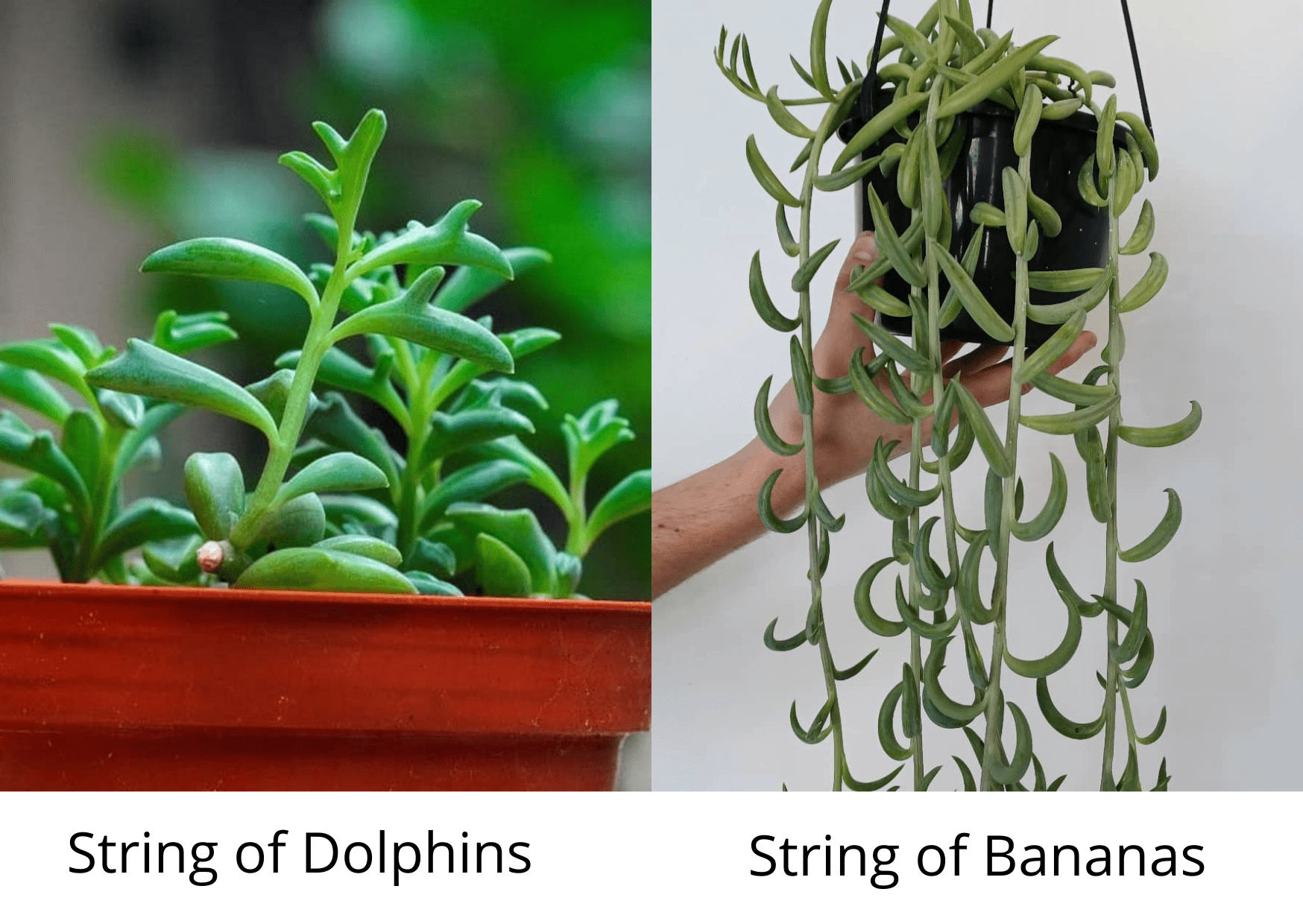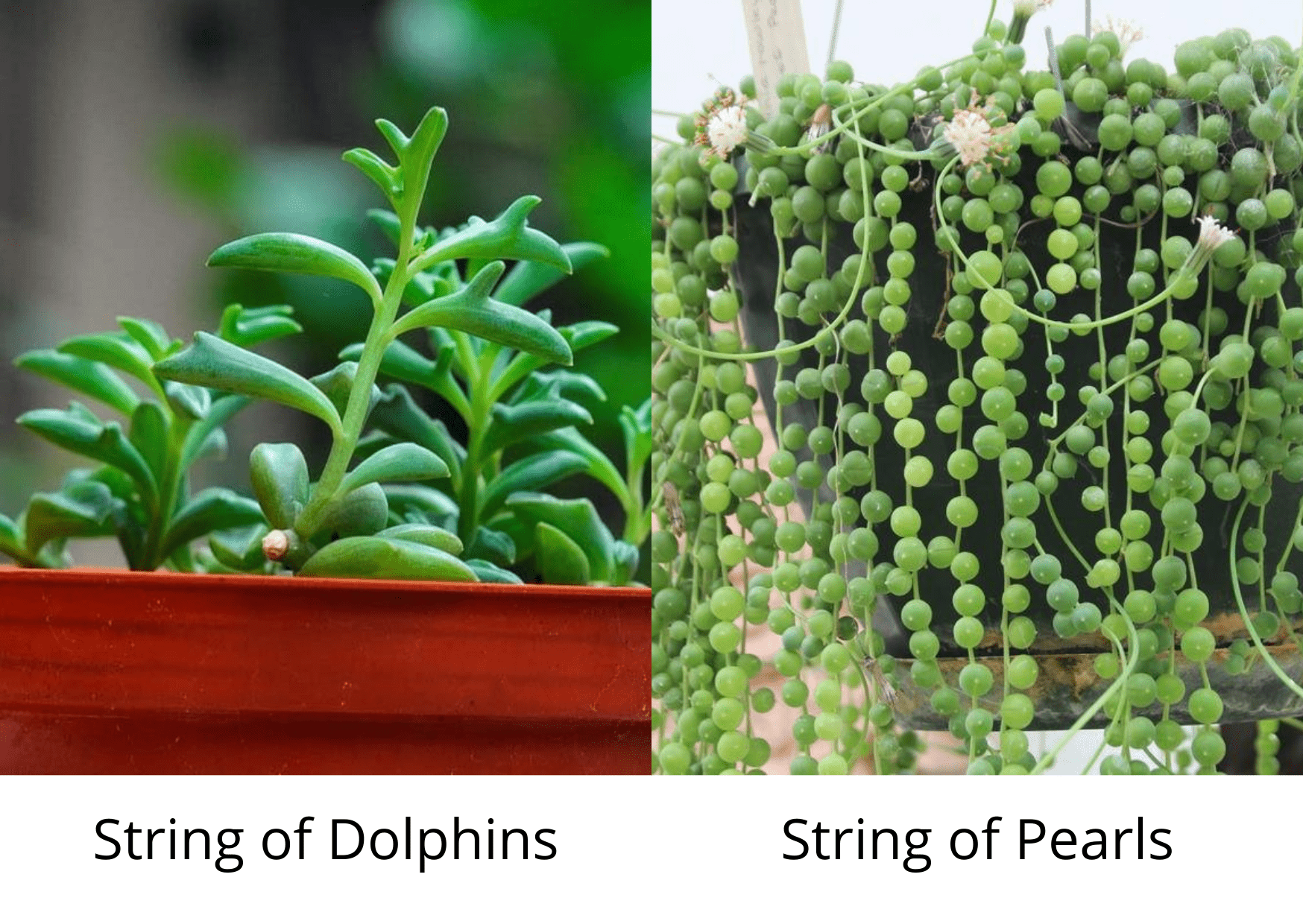String of dolphins is a succulent plant with easy care needs, yet it loses its dolphin-like leaf shape when overwatered alongside other care mishaps.
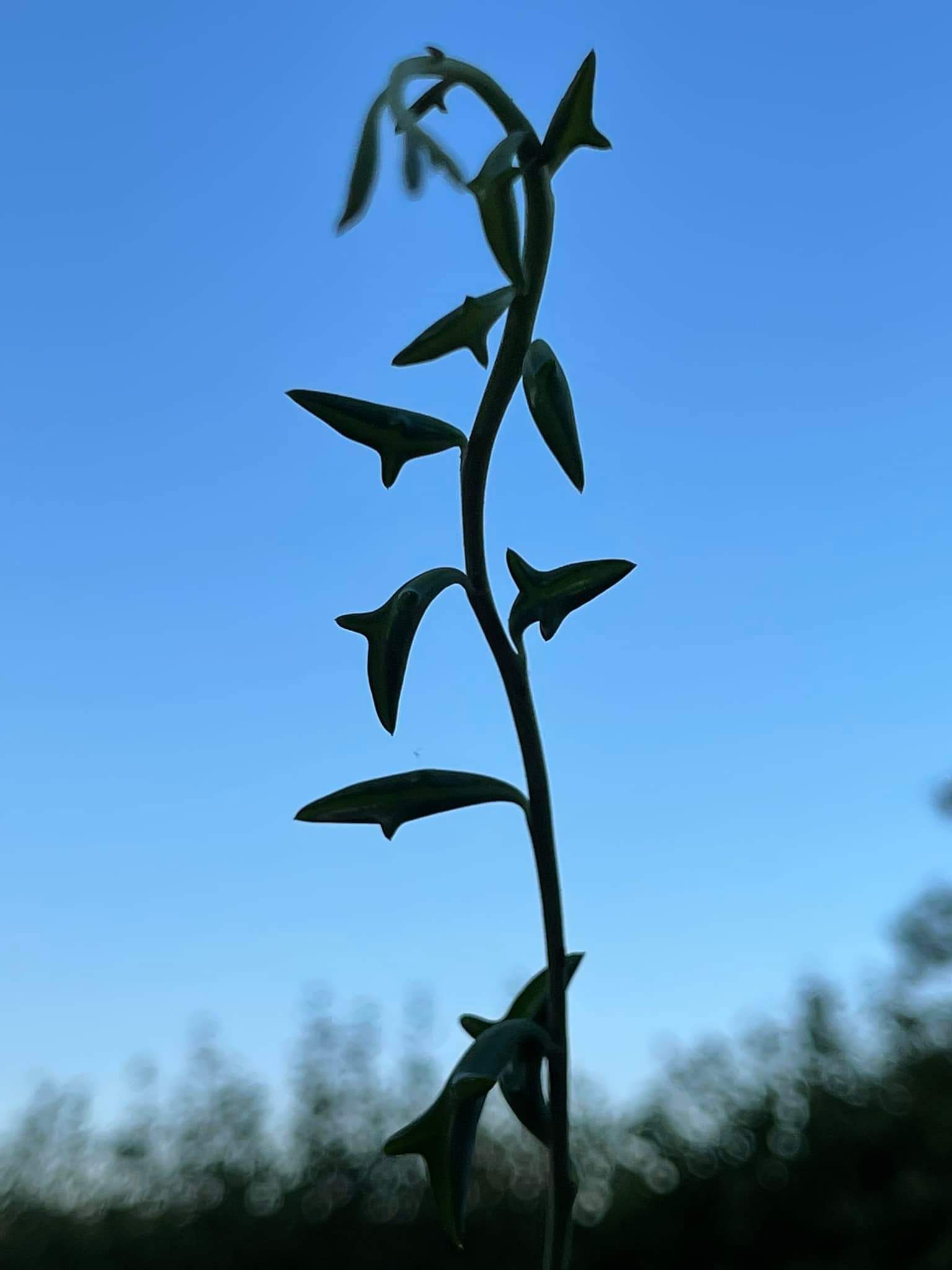
The dolphin plant is popular among plant enthusiasts due to its unique foliage that represents dolphins.
Let’s dive deeper and learn more about this mesmerizing plant.
Table of Contents Show
Overview of String of Dolphins
The string of dolphins got its name from its unique foliage that looks like leaping dolphins. It is a cross between a string of pearls (Senecio rowleyanus) and a candle plant (Senecio articulatus).
This plant, with the scientific name Senecio peregrinus, is a rare plant to get your hands on.
Let’s look at the basic overview of the dolphin plant.
| Scientific Name | Senecio peregrinus |
| Common Name | String of Dolphins |
| Native Area | Southwest Africa |
| Family | Asteraceae |
| Growth Zone | Zones 9-10 |
| Plant Type | Perennial Trailing Succulent |
| Growth Size | 6 inches tall |
| Growth Speed | Fast paced growth |
| Grown For | Beautiful dolphin-shaped leaves |
| Growth Type | Cascading, trailing growth |
| Container | Plastic or terracotta pots Hanging baskets |
| Flowering | Tiny white flowers in a cluster |
| Flowering Season | Late autumn to early spring |
| Availability | Pretty rare |
| Toxicity | Toxic to pets and humans |
Being one of the succulent plants and having a string of pearls as a parent, this plant shares a lot of properties with string plants.
Where to Buy String of Dolphins?
After looking at a few photos of a string of dolphins online, your heart may ask you to bring one of these beautiful flowers in.
And as the plant is rare, you will have difficulty getting your hands on one of these in your local nursery.
But fret not; we have amassed a list of online sites that will deliver the plant to your home. Look below for the list.
| Site | Shipping Details |
|---|---|
| Logees | Ships within 2 days |
| Almost Eden | Ships usually on Mondays and Tuesdays (Except holidays) |
| Amazon | Delivered in 5-8 days |
| Etsy | Dispatched in 1-2 weeks |
| Succulents Box | Delivers within 3-5 days |
String of Dolphins: Ultimate Care Guide
A string of dolphins is relatively easy to grow and care for. Due to its trailing branches, it is also easy to propagate.
Let’s look at the care requirements of this plant in the table below.
| Parameter | Ideal Requirements |
|---|---|
| Sunlight and Location | Bright indirect sunlight 5-6 hours of sunlight in the south-facing window |
| Watering | Once or twice a week in the summer season Water the plant once or twice a month during winter |
| Temperature | 65°F to 85°F (18°C - 30°C) Anything below 40°F is dangerous |
| Humidity | 40-50% |
| Soil | A porous and well-draining soil Use cactus mix for better results pH: 6.6-7.5 |
| Fertilizer | Feed them with succulent fertilizer every 1-2 months Cut back on fertilization during winter |
| Potting | Once every three years during spring |
| Pruning | Prune occasionally during spring and summer to remove dead or decaying leaves |
| Propagation | Stem cutting |
| Pest and Diseases | Aphids, Mealybugs, Spider mites, and Scale Root rot, Botrytis & Southern blight |
Now let’s go into the details.
1. Proper Sunlight & Warm Location
As an adorable succulent, the string of dolphins needs a good amount of sunlight to grow properly.
These plants hail from the drier parts of Southwest Africa, so they get plenty of light for their growth. It would be best if you emulated its native conditions at home.
The string of dolphins grows best in a location with bright but indirect sunlight for at least 5-6 hours daily.

These plants need to be at a location that provides 800FC of light intensity for good growth. To survive, they need at least 400FC of light intensity.
But how the foliage turns out depends on the amount and quality of light the plant gets.
The perfect color temperature for growing succulents is 6000-6500K.
The plant will showcase the following signs if it is not getting proper sunlight.
| Lack of Sunlight | Extreme Sunlight |
|---|---|
| Leggy growth and etiolation | Yellow, scorched leaves |
| Sparse growth of the foliage | Sunburns on the edge and center of the leaves |
| Shrinkage of the leaves | Leaves will start to curl |
| Lack of chlorophyll causes chlorosis | The stem and soil will dry up |
As the string of dolphins is not a low-light plant, you need to place it in a sunny south-facing window to let it grow to its full potential.
Remember, low light = etiolated dolphin plant, extreme light = dolphin plant turning brown.
You can also grow the plant outdoors if you protect it from harsh light.
Tips to Provide Adequate Light to your plant
- You can keep the plants in the east or west-facing sunny window to provide sufficient light for growth.
- If you plan to keep them in a south-facing window, keep them 3 feet away from the window, avoiding the direct sun.
- Occasionally rotate the plant so the light gets distributed evenly on all sides.
- If your plant is growing upwards, move them to a location where it gets bright sunlight.
- In the process of protecting the plants from too much sun, do not end up putting the plants in areas with low sunlight.

- The best location to keep the plants is in the presence of partial shade, like a balcony, a window, or a basket.
- During winter or overcast days, when light is scarce, you can also resort to artificial grow light to fulfilling the plant’s light requirement.
- If the sun is mild in your area, you can keep your plant in the shade for almost all day.
2. Proper Watering
As a drought-tolerant succulent plant, you don’t need to water this plant too frequently during its active growing period.
Generally, the string of dolphins requires watering once or twice weekly during summer and once or twice a month during winter.

If your plant gets off-peak direct sunlight and is in a 5-inch pot, you can water the plant with 210 milliliters of water every nine days.
Similarly, if your plant doesn’t get direct sunlight, you should water string of dolphins with 190 milliliters every 12 days.
Be wary of the water quality you use for the plant. Use distilled or rainwater for the plant, and avoid tap water as it contains minerals that can build up in the soil.
Under or overwatering may have adverse effects on the plant. So, be on the lookout for the following signs.
| Underwatering | Overwatering |
|---|---|
| The plant will start shriveling | Root decay and rot |
| You'll find yellow spot on the leaves | Leaves become brown and mushy |
| The leaves will have a crispy texture | The leaves will start turning yellow |
If you feel your plant is overwatered, you should cut back on the watering frequency and quickly inspect the roots for signs of rot.
Similarly, if the plant is showing the symptoms of underwatering, immediately soak it in water and let it stay for about 15 minutes.
Tips for watering your plant Properly
- As succulents do not need much water, allow the soil to dry out thoroughly before watering the plant again.
- Respect the plant’s dormancy and water the plant only as suggested, or you will notice the string of dolphins’ flat leaves.
- The best watering method for this plant is the “soak and dry” approach. Water till you see the water ooze out the drainage hole.
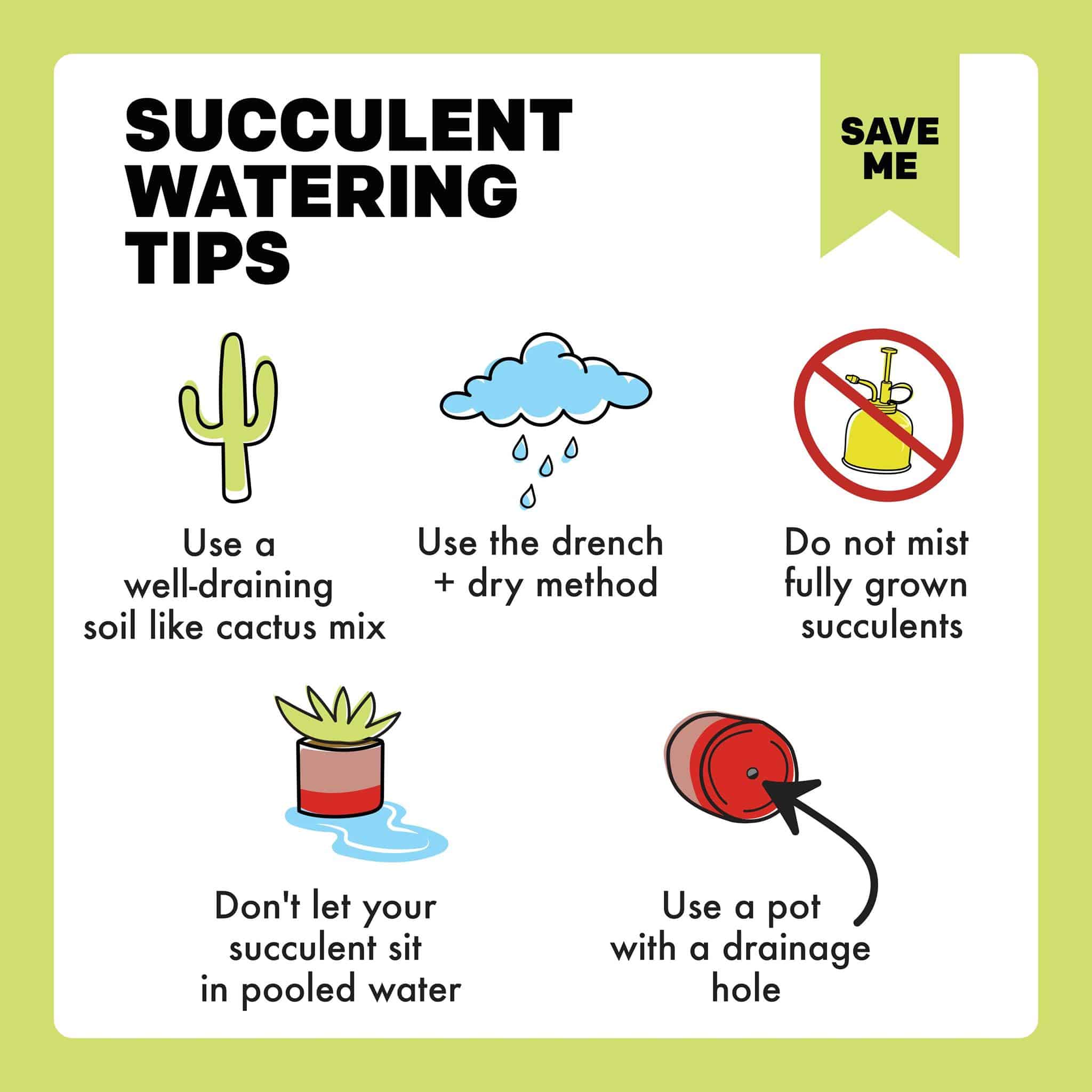
- For using tap water, let the tap water sit overnight.
- Do not water the plant with too hot or too cold water. Water at room temperature is best for the plant.
- The best time of the day to water the plant is early in the morning when the plant is fresh.
- Do not bottom-water the plant, as you cannot perform the soil-moisture test.
- Remember to not underwater the plant, or you will end up with your dolphin plant drying up.
You may notice your succulent dolphin losing shape, flattening out, and wondering ‘how to revive a string of dolphins.’
In such cases, you need to hold off the watering till the plant thrives with life.
3. Warm Temperature
Like a string of dolphins, succulents from the Asteraceae family have varied temperature needs that change according to season.
The string of dolphins grows best when the temperature ranges from 65°F to 80°F (18°C to 30°C). They can withstand cooler temperatures up to 40°F at night.

If the daytime temperature drops below 35°F, the plant is in real danger as they may even succumb to death.
But the real problem starts when the temperature drops to frosty conditions, as the plant is not frost-hardy.
When the weather is frosty, ice crystals form on the plant cells. This disrupts the working mechanism of the plant, severely damaging it.
The optimum temperature at which these dolphins grow is between 65°F and 72°F (18°C to 22°C).
If the temperature exceeds the plant’s comfort zone (90°F), transpiration will occur faster, and the plant can dry, burn and die.
Tips to Maintain Optimum Temperature for your plant
- If the temperature is too low, you can use incandescent light, a grow light, to provide your plant’s temperature needs.
- During extreme temperatures, water the plant more frequently and increase humidity around the plant as well.
- Heating pads and frost blankets are good options to keep your plant warm during early fall and frosty conditions.
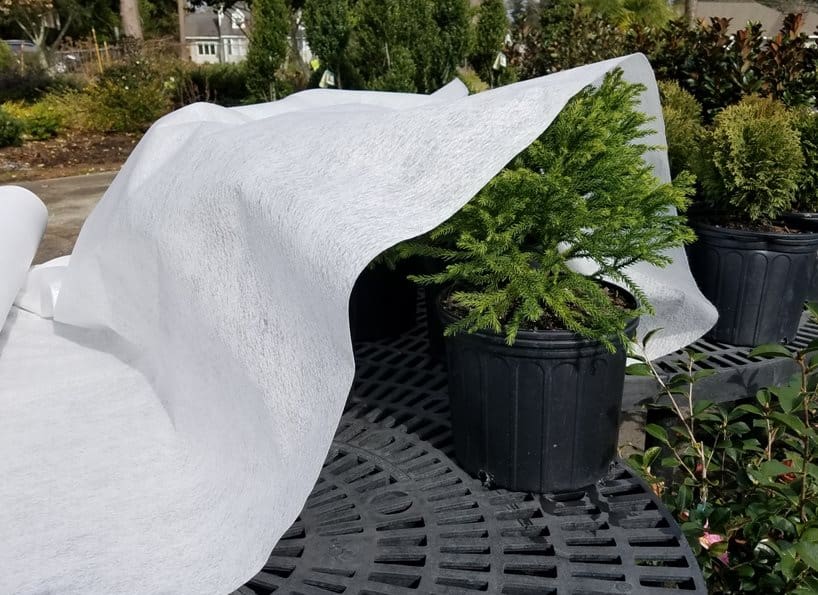
- You can create a mini greenhouse for the plant to maintain the temperature.
- If you have kept your plant outdoors, frost conditions are the best time to bring them inside.
4. Medium Humidity
As the cutest succulent, the string of dolphins does not like too much humidity.
Generally, the string of dolphins prefers a medium humidity level ranging from 40% to 50%.
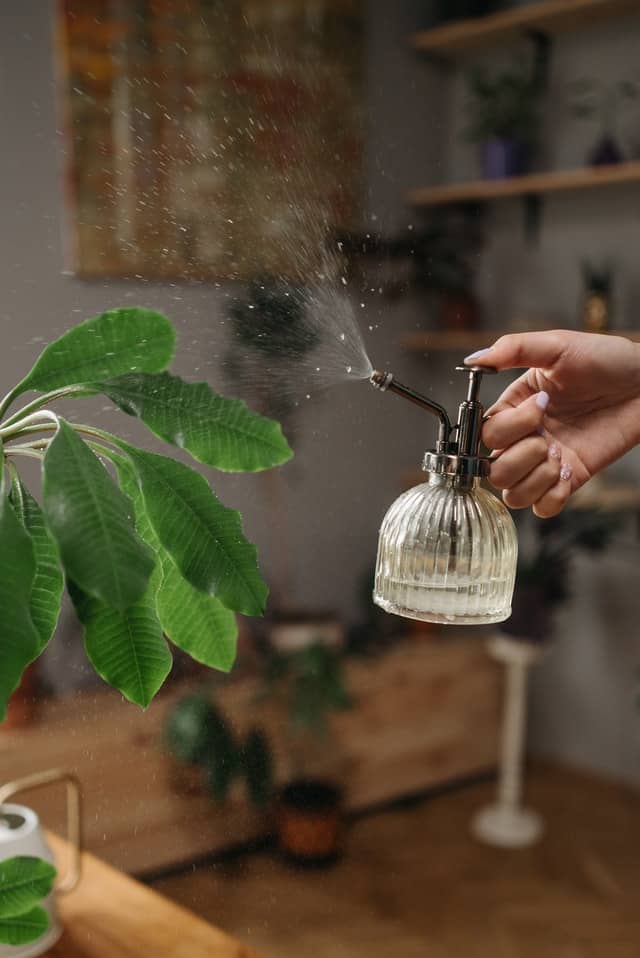
The thick plant’s leaves can hold up a lot of moisture. So, there is already enough moisture for the plant to sustain.
As the plant is ‘drought-tolerant,’ it doesn’t need too much environmental moisture.
But low humidity and high humidity both have their effect on the plant’s growth. Let’s look at the impact in detail below.
| Low Humidity | High Humidity |
|---|---|
| Leaves will wilt and shrivel | Root rot |
| Yellow and brown leaf tips | Fungal growth |
| Leaves may fall off | Grey mold on the leaves |
Tips to Maintain ideal humidity for your plant
- The best humidity locations for houseplants are in the kitchen or bathroom.
- As your plant doesn’t love too much humidity, do not mist them regularly.
- You can use dehumidifiers or air conditioners if the humidity is too much near the plant.
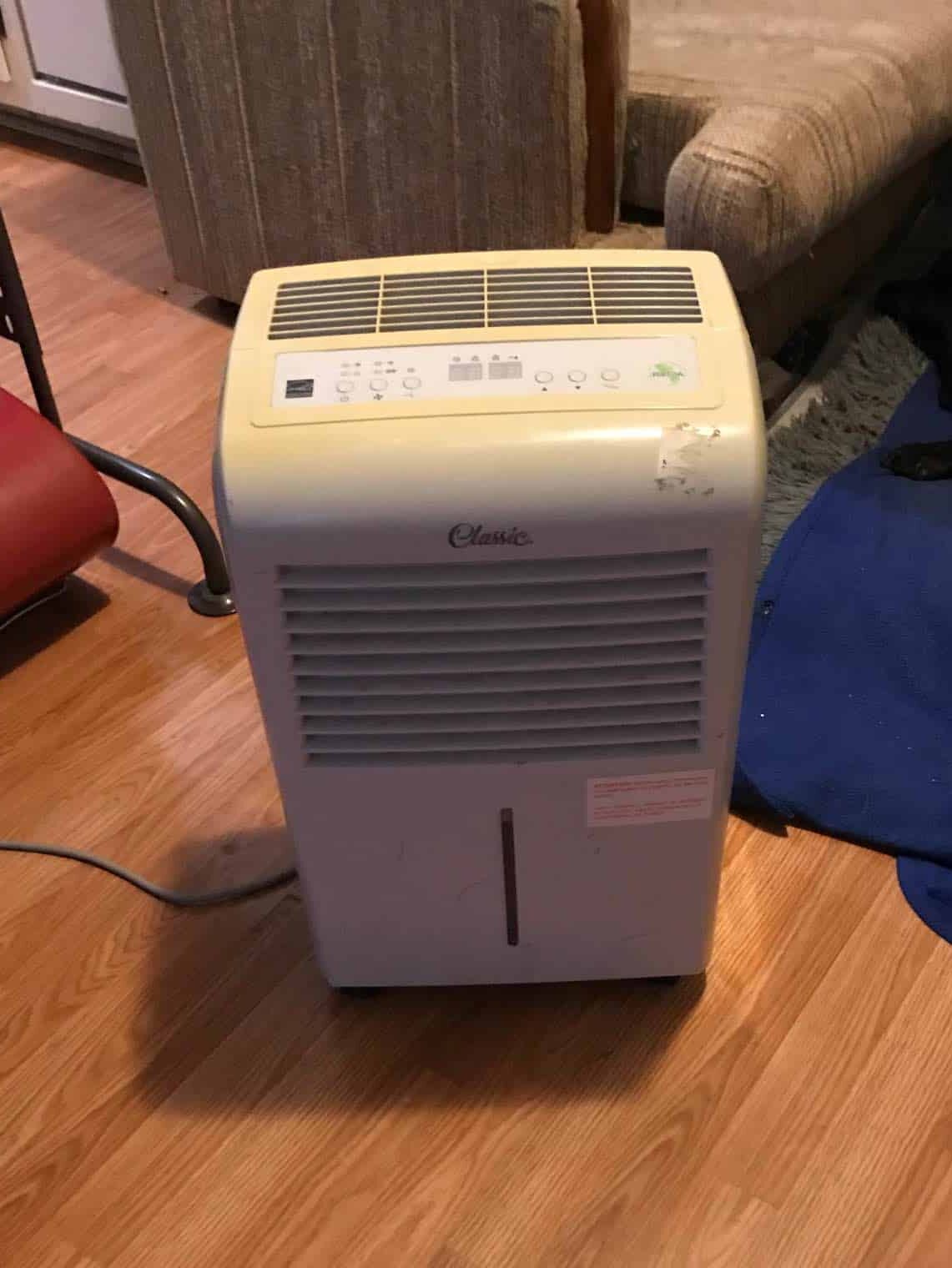
- Keep your plant in the path of moving air to keep the humidity in check.
- In case of low humidity, keep a wet pebble tray near your plant to provide humidity.
- You can occasionally mist the plant during drier weather to provide it with moisture.
5. Porous, Well-Draining Soil
A plant’s growth usually depends on the quality and texture of the soil you provide. A string of dolphins is no different.
Generally, the string of dolphins requires porous, well-draining, and arid succulent soil with a pH ranging from 6.6-7.5.
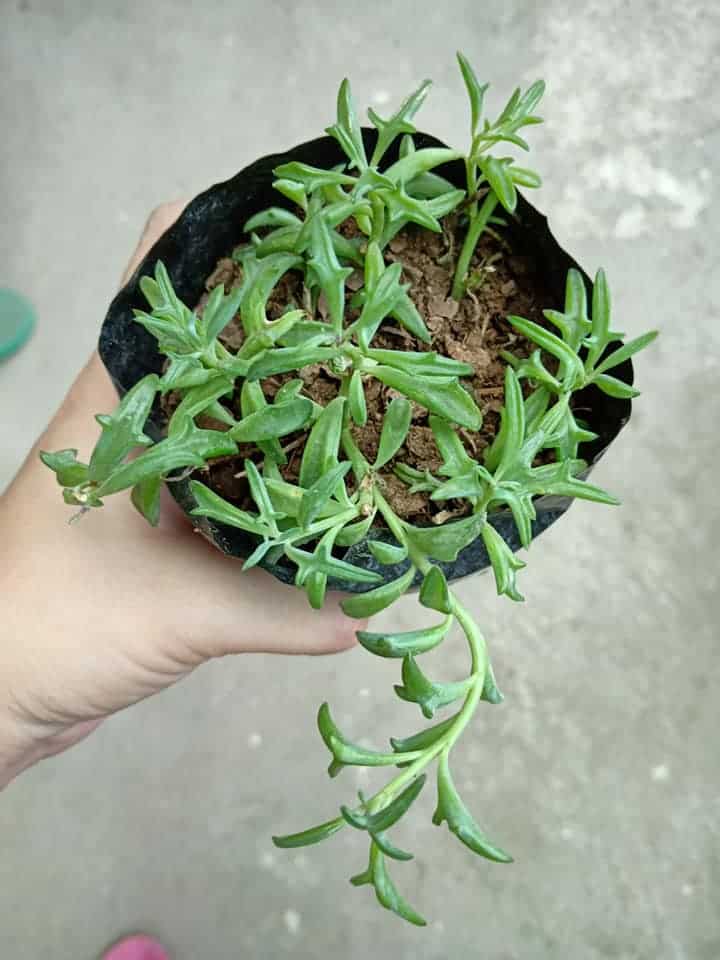
This plant can throw tantrums if the soil is not good enough. As a succulent, this plant will suffer from root rot quickly if it stands in excess soil moisture.
For an easy option, you can choose a cactus or succulent mix for your plants. Throw perlite into the mix, and you are good to go.
The above type of soil provides good aeration to the roots and helps retain the nutritional values of the soil line.
You can also prepare the perfect soil mix for your plant at your home. See below for a few recipes.
- One part of perlite, One part of gritty rocks, Two parts of potting soil
- One part sand, One part pumice, Two parts potting soil
- Three parts of potting soil, Two parts of coarse sand, One part perlite or pumice
There are a few commercial options available as well.
- Miracle-Gro Succulent Mix
- rePotme Cactus and Succulent Potting Soil Mix
- Miracle-Gro Indoor Potting Mix
- Noot Organic Indoor Plant Soilless Mix
6. Monthly-Bimonthly Fertilization
The string of dolphins is a hardy plant that can thrive even in the harshest conditions. It doesn’t require too much fertilizer for growth.
But providing the plant with timely fertilizers can benefit the long run.
Generally, the string of dolphins requires a dosage of succulent fertilizer every 1-2 months during its growing season.

During its dormant period, it would be best to cut back on fertilizing as it may accumulate on the top of the soil and damage the plant.
You can also go for light feeding during spring with an organic fertilizer such as liquid kelp, fish emulsion, or worm compost.
The dolphin succulent performs well if you feed them with a liquid organic fertilizer that has been toned down to half its strength.
However, they may showcase the following problems if you overfeed or underfeed your plant.
| Under Fertilization | Over Fertilization |
|---|---|
| Foliage will lose its color | The plant will have a slow growth |
| Plant will show chlorosis | Plant will be susceptible to pests and diseases |
| Leaves will turn purple | The plant will lose its signature dolphin look |
The main gist is to understand your plant’s needs and fertilize only when necessary. Your plant will submit quickly to over-fertilization damages.
Look below for the few fertilizers that are good for the plant.
- AeroGarden Liquid Nutrients: NPK 4-3-6
- Scotts Turf Builder: NPK 20-0-8
- Jobe’s Organics: NPK 9-8-7
As a plant grown for foliage, you can go for a fertilizer rich in nitrogen content.
7. Repotting Every Three Years
As a hardy succulent, the string of dolphins can handle being rootbound and does not need frequent repotting.
Although the growth pace of this plant is pretty fast, you can manage the strings and give your adorable succulent a fuller look.
The string of dolphins must be repotted every three years in a pot larger than the previous one in a fresh soil mix.
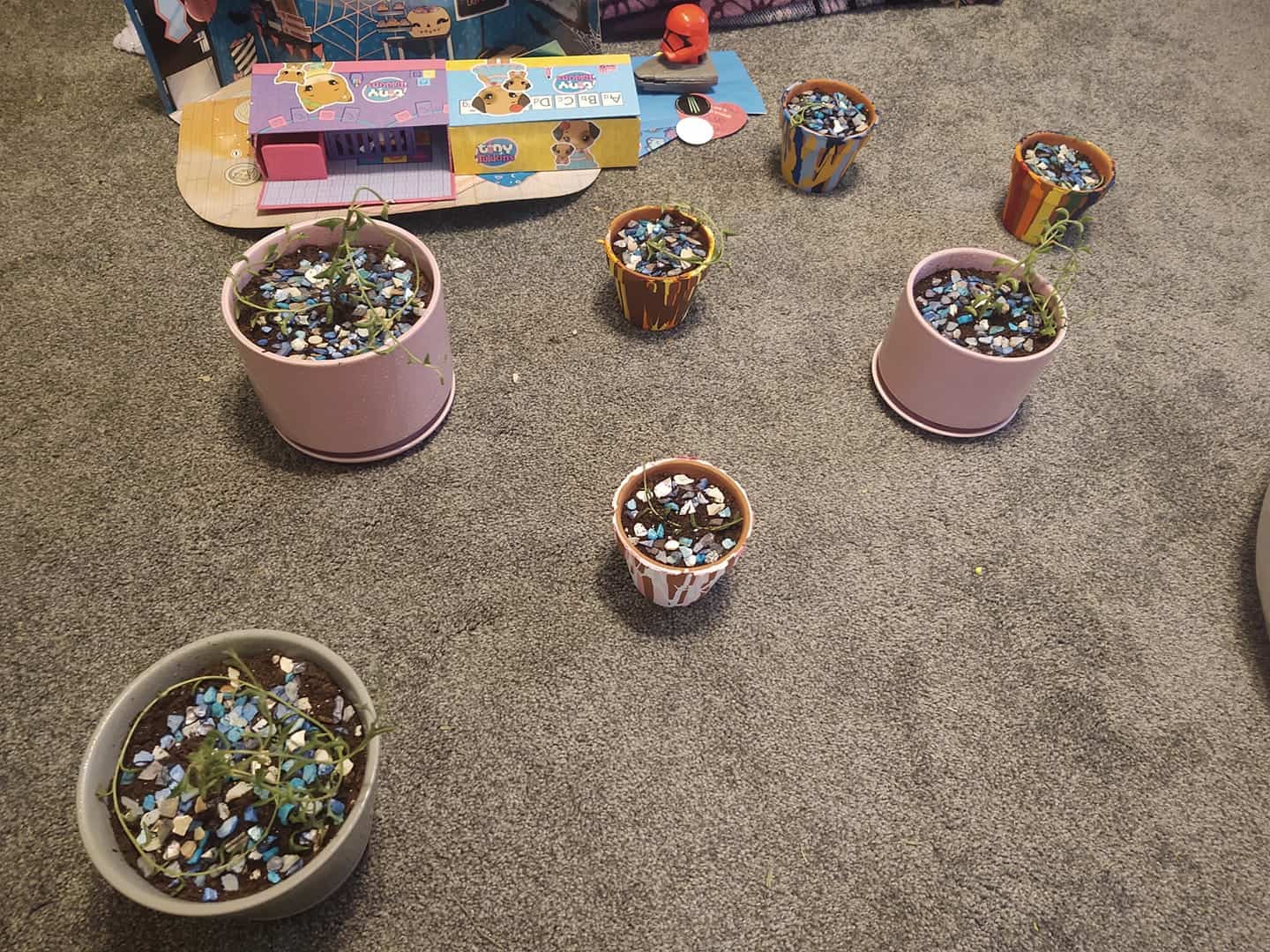
You can use plastic or terracotta pots with good drainage and absorb the excess moisture to let the plant grow to its full potential.
If your plant has doubled in size and the plant’s roots are poking out of the pot’s drainage hole, it is high time you repot it.
While repotting, you can divide the root ball and plant those divisions separately.
To start, you can go for a 4-inch pot or hang the plant in a hanging basket to increase the aesthetic of your room.
Steps to Repot your succulent plant
- Water your succulent thoroughly a day before repotting it.
- Wear proper gloves and gardening gear for the repotting process.
- Remove the plant from the old pot by gently tilting it sideways and tapping the bottom.
- Check the roots properly for any damage signs, cut them if any, and untangle fresh roots with your hands or a knife.
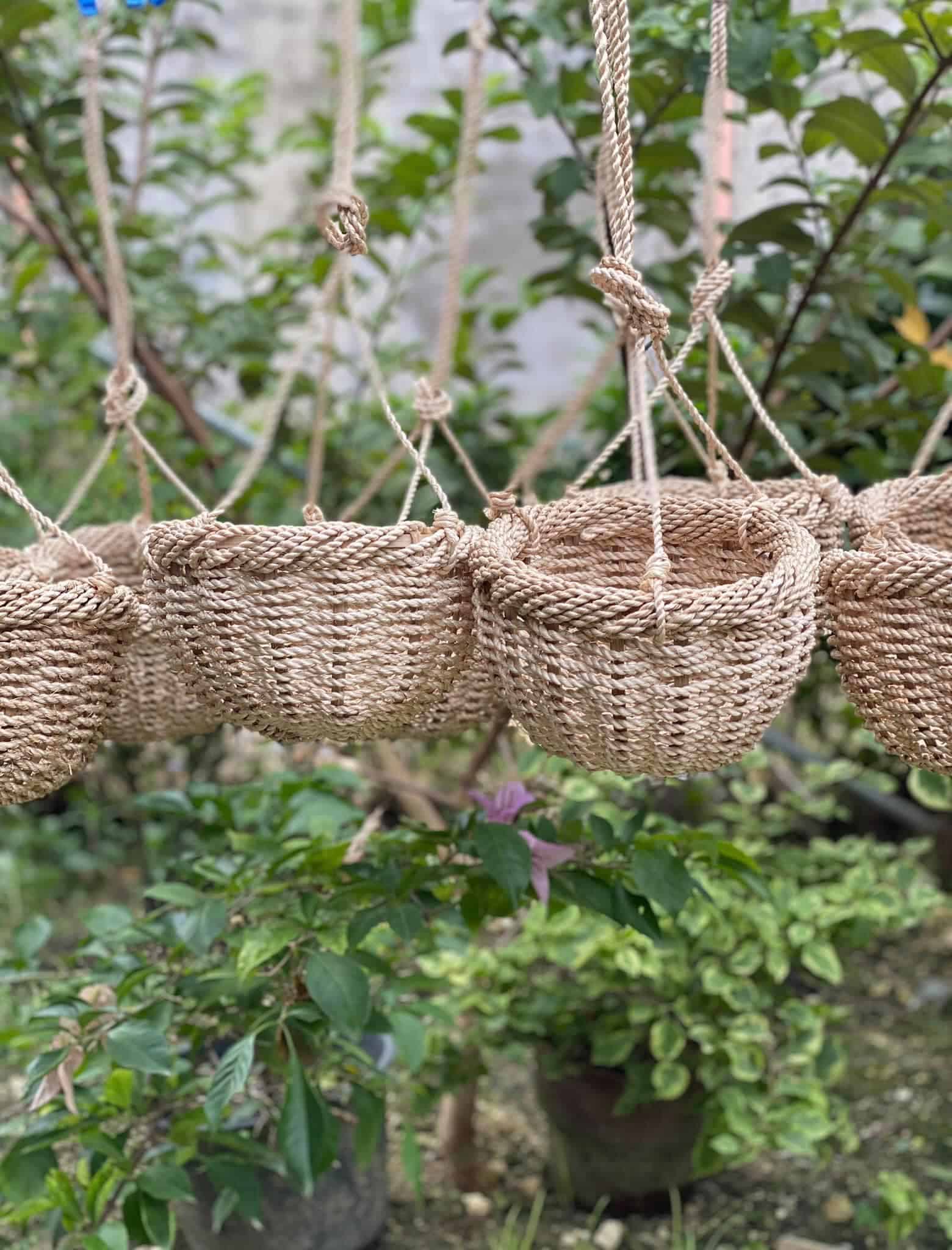
- Take a new well-draining pot with good drainage holes and fill the base of it with fresh potting soil.
- Place the root ball in the pot and fill the remaining space with potting soil. Leave some room for future fertilization.
- Place the plant in a spot with adequate light and warmth.
Remember, a pot with good drainage is essential for the dolphin plant as that plant is quick to incur waterlogging and root rot.
8. Occasional Pruning
Those long vines of the string of dolphins can be quite problematic and messy as this plant grows at a good speed.
However, if you manage the string properly, you can completely skip pruning it.
Generally, you can prune the string of dolphins now and then to maintain its good look and aesthetics.
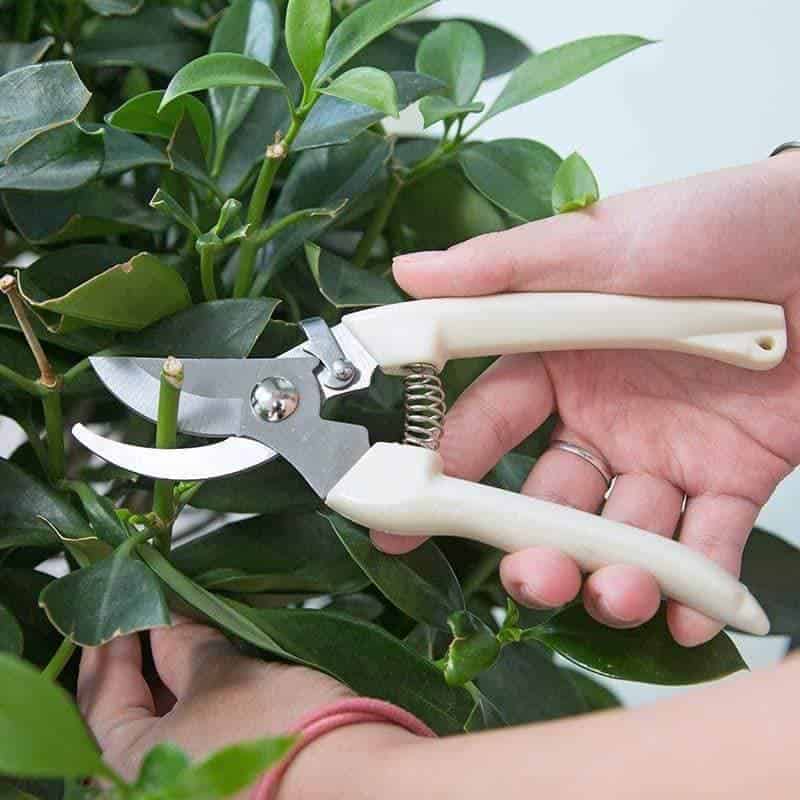
Remember that you should prune the plant during spring and summer when the plant can get over any type of pruning shock.
You need to target the old, dead leaves and stems while pruning. Pruning them can encourage new growth in the plant.
While your plant is hanging in a basket, you can chop off the trailing vines that have grown longer than you want them to.
For pruning, you will need gardening gloves, pruning shears, and rubbing alcohol.
Tips to Prune String of Dolphins
- Sanitize the tools properly before jumping on the pruning process.
- You must ensure that the plant has no underlying stress due to certain factors.
- Look for the damaged or dead stems and leaves of your plant.
- Trim the leaves or stems exactly at the point it connects with the healthy part of the plant.
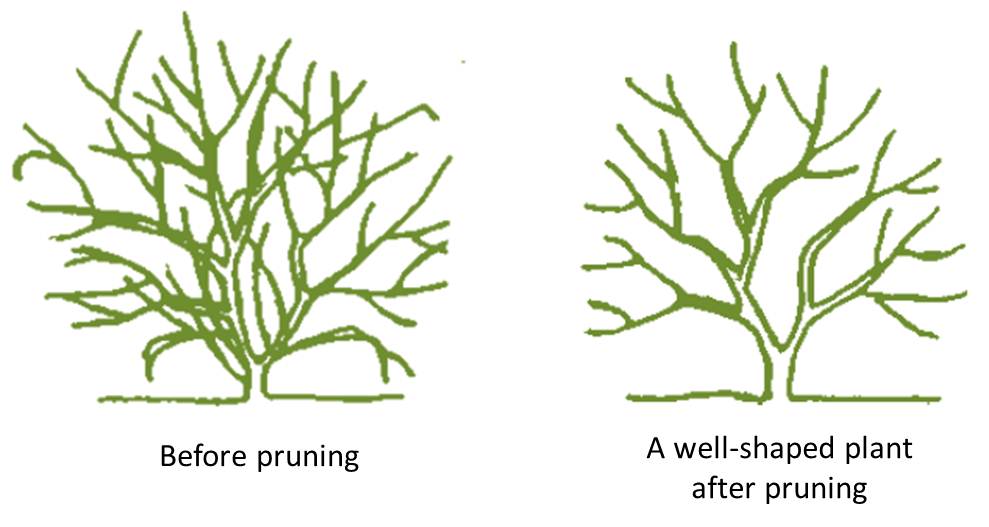
- Do not cut more than one-third of the plant, or it may incur stress.
- If you plan to use the stems for future propagation, you can keep the stems safely. Or, you may just discard them.
String of Dolphins: All About the Growth Rate
Like most succulents, the string of dolphins also has a fairly quick growth rate and can grow to tantalizing lengths in a short time.
Also, this plant allows you to grow it in either a pot or a hanging pot. Pretty handy, right?
Generally, in 9 months, this plant can grow to a length of about 6 inches, while the vines can grow up to a size of 20 inches.

If the plant gets to grow in its natural habitat, the long-hanging tendrils can grow up to a length of 36 inches.
The plant has iconic dolphin-shaped leaves attached to the long trailing stems. If the care is improper, the dolphin plant leaves will flatten out and stop looking like dolphins.
The individual unique leaves are dusty blue-green color, which can change color depending on the amount and quality of light.
String of Dolphins Flower
The string of dolphins is popular and is grown for its beautiful foliage. But, if you look at the white flowers, they are a different kind of beautiful.
This plant produces white mini flowers with pink, red, or yellow stigmas growing in clusters on receptacles during early spring and summer.

Apart from that, the flowers have a good cinnamon smell like other plants in the ‘string’ family.
To make this plant bloom, you must let it mature first and then force dormancy on the plant during the winter.
You can collect the plant’s seeds from the flower after it is spent. It produces small seeds that are of brown and black color.
If you germinate the seeds, they will take about a month to grow out a sprout if you provide them with good care.
We have a similar article for you: String of Pearls flower
Toxicity of String of Dolphins
The string of dolphins is a pretty houseplant to keep in your house. Due to its unique, striking foliage, you would want to get one for yourself.
Although unique, this plant doesn’t have many benefits other than being an ornamental plant and a low-maintenance plant.
Moreover, the string of dolphins and other Senecio plants are toxic to cats, dogs, and horses as they contain Pyrrolizidine alkaloids.

Pyrrolizidine alkaloids are toxins produced by plants as secondary metabolites. This toxin attacks the liver of those who ingest it and damages them.
In pets, consuming the leaves of this plant shows the following symptoms.
- Vomiting
- Anorexia
- Diarrhea
- Weakness
- Grey mucus membrane
- Liver damage (if not treated in time)
In humans, this toxin has a different effect. It induces symptoms like hepatomegaly, splenomegaly, vomiting, diarrhea, and anorexia.

The main toxic parts of this plant are its leaves and stem.
So, the dolphin plant is not edible, and in case you or your pets ever consume this toxic plant, call the following numbers.
- AAPCC at (800) 222-1222
- ASPCA at (800) 426-4435
Propagation Methods for String of Dolphins
The string of dolphins has a beautiful set of leaves that can grab the attention of almost everyone. It is no wonder to want many of these plants.
One of the ways to do that is to order it online. But, you also have a cheaper option: propagating string dolphin plants.
Generally, we can propagate this plant using stem cuttings, seed propagation, and sphagnum moss propagation during the plant’s growing season: spring or early summer.
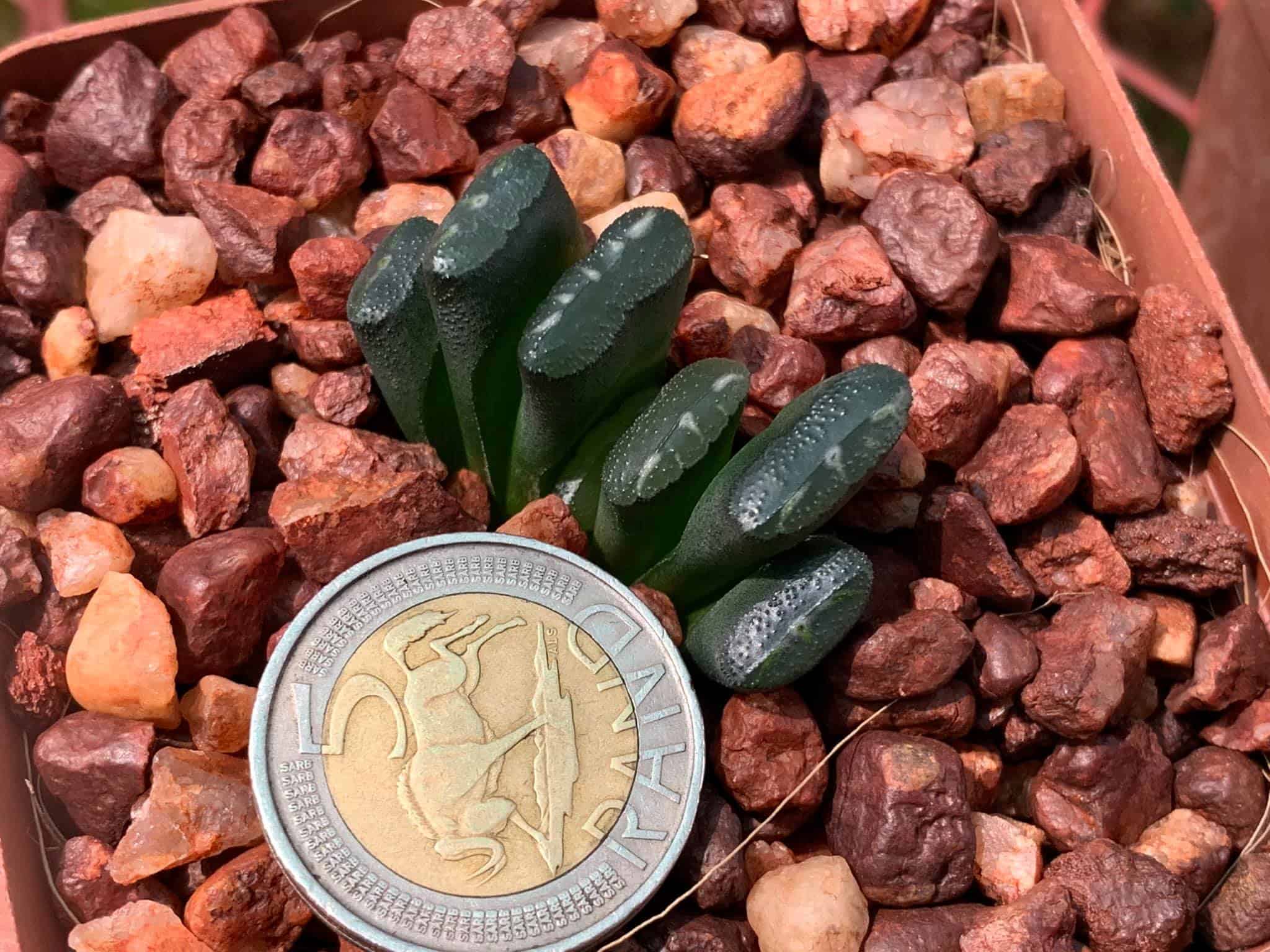
But, germinating the plant using the seeds can be very tedious and is the least preferred method among the two of them.
So, we will be learning about how to propagate this plant using the most popular and preferred method: stem cuttings and the least preferred method: seed propagation.
Gather the following materials before jumping into the propagation business.
| Materials Required | Purpose |
|---|---|
| Gardening Knife | For stem cutting |
| Gardening Gloves | For safety |
| Potting Mix | Potting Medium for String of Dolphins |
| Perlite | For extra drainage |
| Rooting Hormone | For best growth |
| Terracotta Pot with a Drainage Hole | Well draining container for String of Dolphins |
Propagating via Stem Cuttings
As one of the easiest ways to propagate the dolphin plant, you will not have to work too hard to propagate your plant.
First, you have to look for a healthy stem with 2-3 nodes and cut 3-5 inches of it with clean, sterilized pair of scissors.

Strip the leaves cutting at the bottom, and let it stay for up to 2 days to form callus. Now you can choose whether to root them in water or soil.
1. Rooting in water
- Choose a clean, transparent pot and fill it with distilled/rainwater.
- Add a few drops of rooting hormone to the water to ensure better and faster rooting.
- Place the cutting in water so the nodes are in, but the leaves are out.
- Put the cutting in a location where it gets enough sunlight and warmth. A west-facing window will be good.
- Replace the water every 6-7 days to remain fresh and the nutrients get replenished occasionally.
- You will witness new roots in a couple of weeks. It is time to relocate the cutting to a fresh potting soil mix.
2. Rooting in soil
- Get a container and prepare the recommended well-draining soil mix. Remember, the pot should have adequate drainage holes.
- Dip the end of the cutting in a rooting hormone to promote accelerated growth.
- Press the soil of the potting mix in the middle with your forefinger and place the cutting there.

- Ensure the node gets inside the soil and the leaves stay out. Dab the soil around the bottom of the cutting to let it stay firmly.
- Place the plant in a sunny location and water only when the soil feels dry to the touch.
You can also propagate this plant by leaf propagation. Just choose a mature plant and cut a healthy leaf out of it.
The propagation process is simple and similar to the one above. To root the leaf in the soil, simply place it on the soil.
Propagating via Seeds
Although a hard journey to embark on, propagating this plant via seeds is fun if you are an avid gardener.
You can collect the seeds from your plant’s flower after they have dried up or buy some from any online shops or local retailers.
After you have collected seeds, follow the steps below to ensure better propagation.
- Take a clean bowl, fill it with warm water, and soak the seeds in it for about 30 minutes. Keep the seeds soaked until the water turns cold.
- Get a germination tray and fill it with a well-draining potting mix.
- Sprinkle the seeds over the soil and press them gently about half inches deep with your thumb.
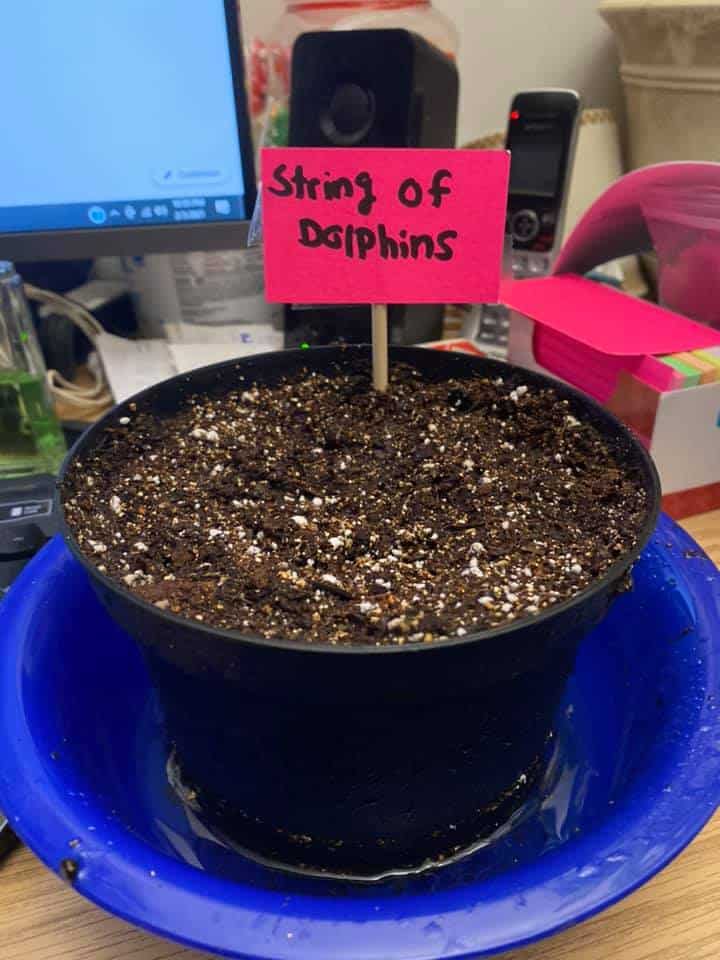
- Make sure there is a distance of at least 1 inch between the seeds.
- Uniformly sprinkle a little bit of potting soil over the seeds.
- Water the soil every 3-4 days or every time they have dried out completely.
- The seeds will take a few months before they become saplings.
Propagating in Sphagnum Moss
Sphagnum moss makes a great rooting medium for your lovely soft succulent.
Look below at how to propagate the dolphin plant in sphagnum moss.
- Choose a long healthy cutting from the plant with multiple leaves and nodes.
- Cut it into small pieces so each cutting contains at least one node and leaf.
- Take a large tub and fill it with sphagnum moss. Sprinkle the cutting onto the tub and press them to ensure the node touches the moss.
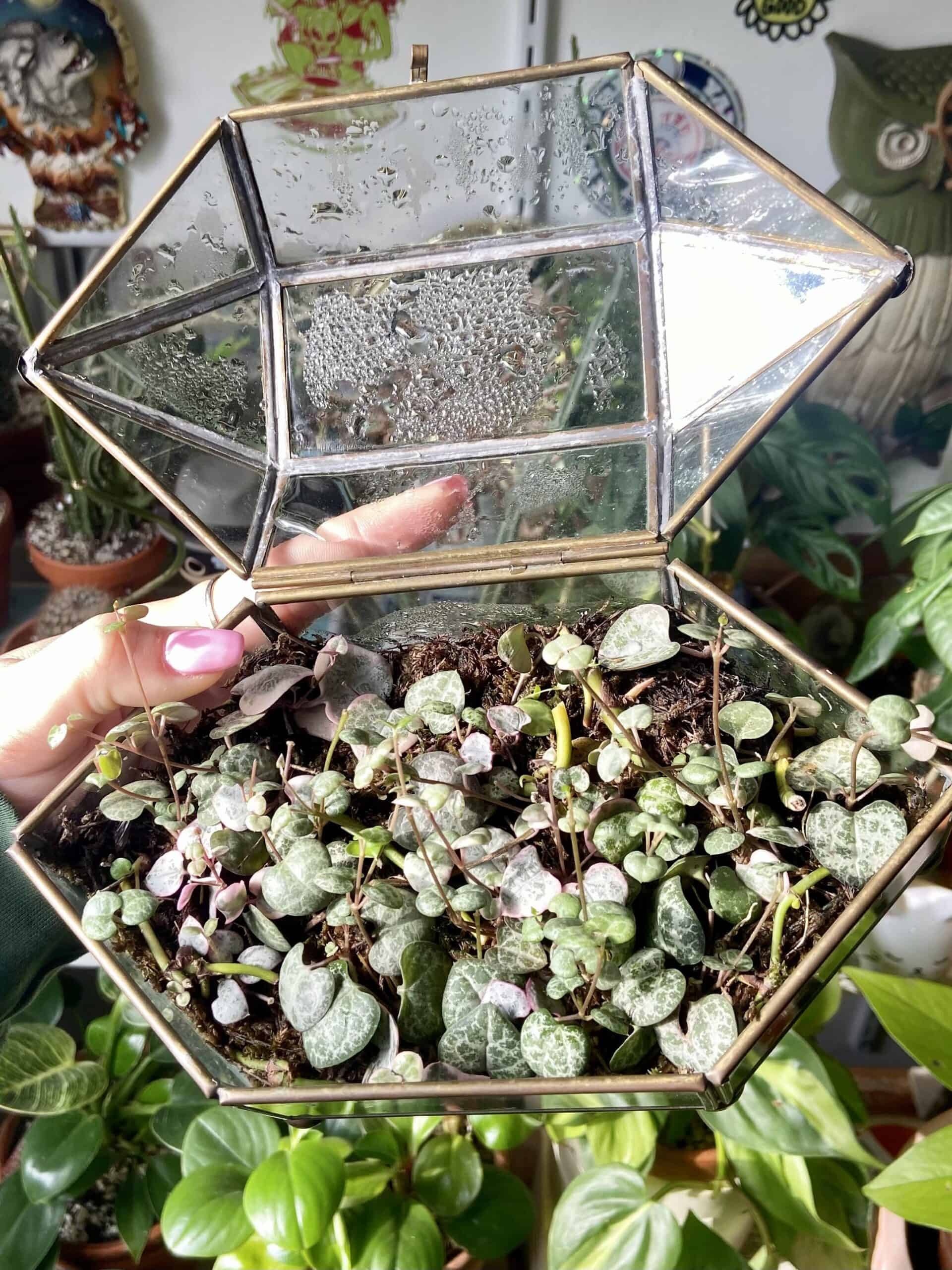
- Cover the pot with plastic to make the environment humid.
- Place the tub in a place with good warmth and good light.
- You will notice the cuttings develop roots in 1-2 months. Congratulations, you successfully propagated the string of dolphins in sphagnum moss.
Common Problems in Dolphin Plant
The dolphin necklace is a great plant to grow indoors as its care requirements are sorted and easy.
But, sometimes, even the hardiest and mightiest plants can incur some damage due to conditions and other factors.
Let’s look at the problems your plant may face while growing.
1. Common Pests
Pests are small but destructive insects or animals that target crops, plants, food, etc.
This plant with dolphin shape leaves and thick roots is a juicy succulent that can be a great food resource for pests to feed on.
Common houseplant pests like aphids, mealybugs, scales, and spider mites attack this beautiful trailing succulent and feed on its juices.
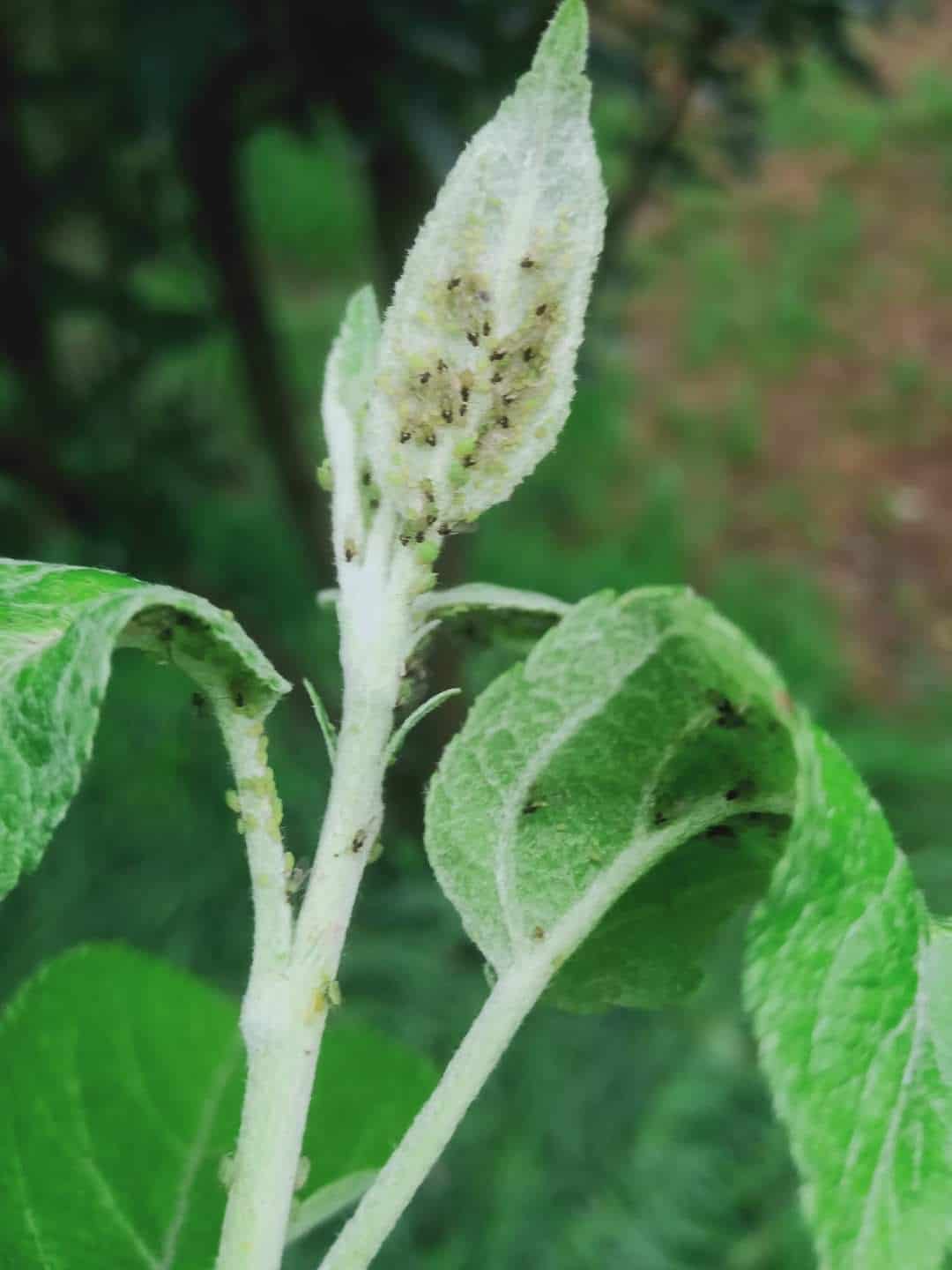
Look at the table below to find out what the pests look like and their threat.
| Pests | Symptoms |
|---|---|
| Mealybugs | Oval shaped, soft, waxy bodies. Curling, wilting and dropping of the foliage |
| Scales | Small, brown, round lumps Pock marks on leaves, leaves falling off |
| Spider mites | Tiny, moving dots on webs Leaves will turn yellow and fall off. |
| Aphids | Stunted, yellow, curled leaves. |
Treatment for Infestation
- Rub the infected leaves with a 70% rubbing alcohol solution using a Q-tip or a cotton swab to eliminate spider mites.
- You can trim the infected parts off the plant to control the infestation.
- Spray horticultural and neem oil on the plant’s foliage to eliminate the pests.
- You can also use a blunt knife to scrape off the pests if the infestation is not severe.
- Use Malathion and Pyrethrin spray as a last resort if the infestation is worst.
Preventive Measures
- Control the amount of water and humidity around your plant, as they are the main culprit of inviting pests.
- Before bringing a plant inside, thoroughly inspect the plant for any pests or eggs.
- Give the plant a regular checkup and monitor for any signs of pests.
- Wash your plant regularly with soap water and keep the leaves free of blemishes and dust.
- Keep your plant in places where there is good airflow.
2. Common Diseases
Plants like the dolphin necklace and other succulents with high moisture are prone to different bacterial and fungal diseases.
Although, the main culprit in infecting this plant with diseases is different fungi that occur on waterlogged soil.
The diseases that affect this trailing are root rot, botrytis blight, and southern blight.

Let’s look at the causative agent and the effect these diseases have on the plant.
| Diseases | Causative Agent | Effect on plants |
|---|---|---|
| Root rot | Rhizoctonia, Phytophthora, Pythium, and Fusarium | Smelly and rotten roots Mushy stem, Slow growth |
| Botrytis blight | Botrytis cinerea | Blight in leaves, undeveloped and rotten buds |
| Southern blight | Sclerotium rolfsii | Loss of color in lower leaves Wilting in the foliage |
Treatment Measures
- First, you need to separate the infected plants from the healthy plants to control the spread.
- Suppose you witness your string of dolphins turning blue or black. It may be due to spots created by rot.
- Take the plant out of the pot and clean the roots in running water. Then cut the infected roots to control the rot.
- If the infestation is too much to handle, you may need to change the potting soil and repot the plant entirely in new soil.
You can still recover the plant from root rot if you see some healthy white roots.
- To treat Botrytis blight, you may need to destroy the infected parts of the plant. You can also use fungicides for the control.
- For southern blight, you can treat the soil with heat, cultural manipulations, biological treatments, etc.
- You can use fungicides like Garden Safe, Bonide, etc., to treat fungal infections.
Preventive Measures
- Avoid overwatering this plant, as it is the prevailing cause of fungal diseases in many plants.
- Regularly check the plant for the initial signs of diseases.
- While bringing a plant home, check it thoroughly for any prevalent diseases and infections.
- Keep the plant away from extreme humidity and damp locations.
- Sterilize the potting medium properly before letting your plant grow on it.
The String of Dolphins in Contrast to Other Varieties
If you take the obvious shapes and sizes of leaves out of the equation, the “string” plants can be very confusing.
And rightly so, the string of dolphins will resemble its parent, the string of pearls.
Let’s look at the plants that closely resemble this plant.
String of Dolphins vs. String of Bananas
From a distance, the growth habits of the string of dolphins and the string of bananas may look the same.
But if you look closer, you may notice a difference in the shape of their leaves.
The dolphin string has individual leaves that look like jumping dolphins, whereas the string of bananas has banana-shaped individual leaves.
Their growth habits, family name, and plant care requirements are the same. So, you must look carefully at the leaves to differentiate between them.
String of Dolphins vs. String of Pearls
The string of dolphins plant is a cross between the string of pearls and the candle plant (hot dog cactus).
So, it is no big deal for a child to represent their parent.
The growth habits of both plants are the same, but the main difference is the shape of their leaves.
The string of dolphins has leaves shaped like dipping dolphins, while the string of pearls has a rounder shape, like small balls.
One other noticeable difference between them is their watering needs. The string of dolphins seems to require more water than the string of pearls.
The plant care of dolphins is comparatively easier than that of pearls.
From Editorial Team
The string of dolphins is an intriguing plant to have indoors. People love this plant because of its beautiful set of leaves and the plant care requirements.
However, you must keep your pets and kids away from this plant if you want them safe.
Good luck growing one!

